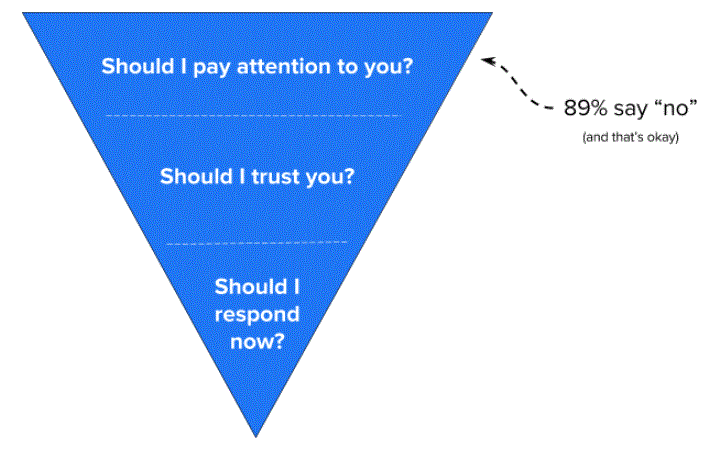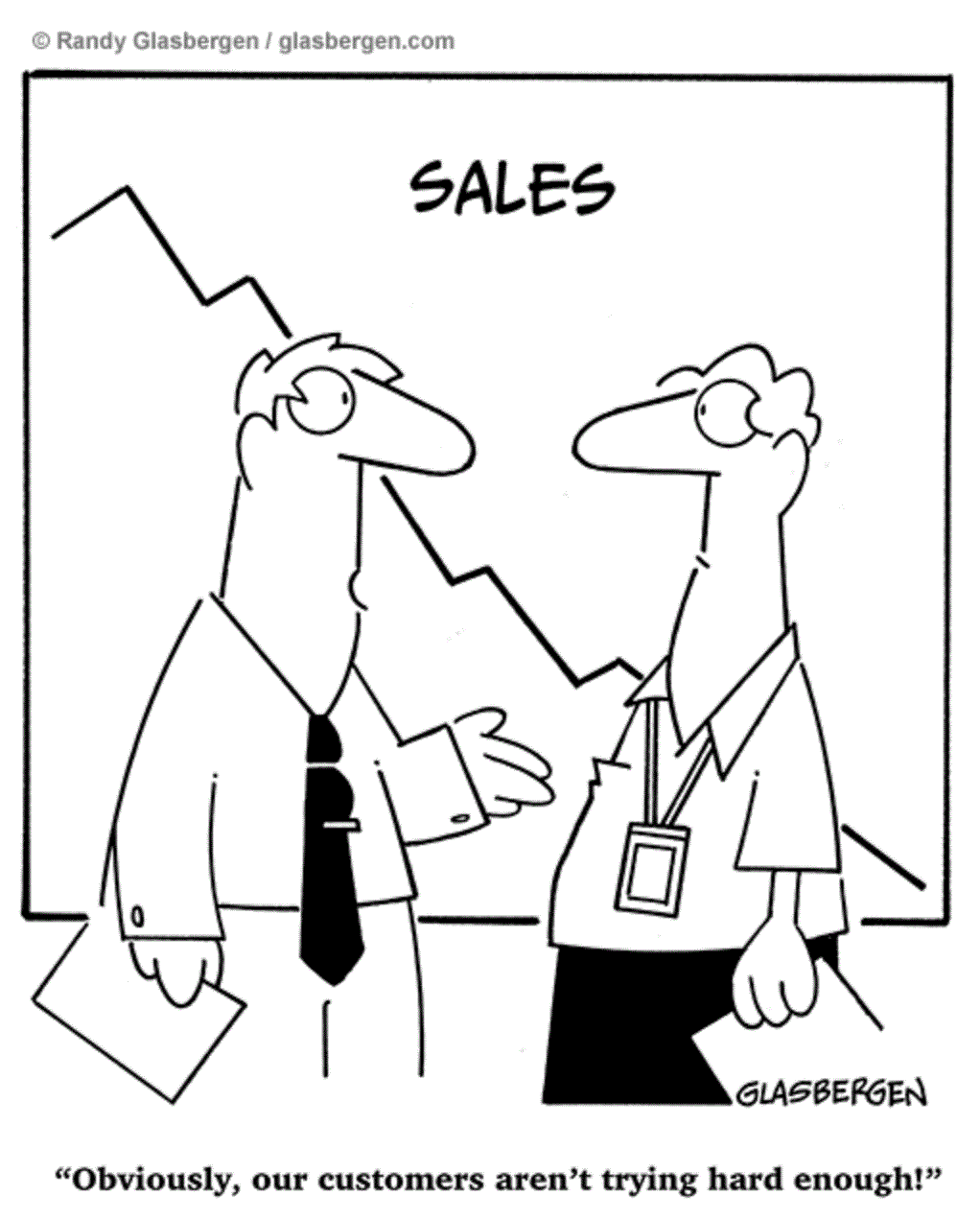Guest post by Liston Witherill, SalesDNA
Sales can feel like a pressure cooker. You’re sitting in a boiling pot and the temperature keeps rising. It’s gettin’ hot in here!
It’s all because starting conversations with complete strangers, and then completing sales is getting more difficult. The pressure keeps rising.
You should know that your prospects feel it too.
Not only that, it’s becoming more of a challenge to get and keep their attention in the first place.
Prospects are bombarded with so many marketing and sales pitches that they’re becoming immune. And the pressure you’re putting on prospects is making them completely allergic to salespeople and sales pitches (though I’m sure you’re lovely otherwise).
Problem #1: The Pitch Glut
There’s something called banner blindness in online advertising. The idea is simple, and you probably have it, too. Since the inception of the Internet, advertising has been the primary driver of revenue. That means you’ve seen tons and tons of ads. In fact, you see over 5,000 ads (on and off line) every day, maybe more.
All of these ads have a strong effect on your brain. It’s not humanly possible to digest and remember that much information, so your brain has created a rule to just ignore them. Why? Because most of the information is unnecessary, irrelevant, and a total distraction. And up to 93% of online ads go completely unseen as a result.

Sometimes reps forget that there’s a delicate balance between quality and quantify in their outbound communications (not you of course, Dear Reader). In 2016, the average rep sent 8+ communications to a prospect before giving up, and higher performing teams are sending between 13 and 20.
This is leading to cold email blindness, and it’s a big problem for sales teams.
Solution #1: It’s a Process, Not a Moment
Starting conversations with prospects isn’t a moment in time. One of the reasons it’s so important to send out multiple touches in a campaign isn’t to annoy or bombard your prospects, but to give them multiple reasons and chances to communicate with you.
Your prospects are either busy, not ready to buy, or just not seeing your communications. Any and all of these may be true. But when they do see your outreach attempts, you’d better make ‘em good because you may not have another chance to get their attention.
When communicating with your prospects, you need to answer three questions for them before you’ll ever get a response:
- Should I pay attention to this?
- Should I trust you?
- Should I respond now?

Your campaigns and communications should be created with these questions in mind. I’ll translate the questions so you can take action on them right now:
- Make it directly relevant to your prospect
- Demonstrate credibility through results, case studies, etc.
- Give a compelling reason to respond now, possibly through a trigger event you observed about them
Rather than reading this article and crafting entirely new campaigns, do this instead: look at your highest performing campaigns, and see if you’re answering the three questions. Make updates as necessary, and test to see what happens.
Problem #2: The Relevance Challenge
It’s no problem to whip up an email sequence like this:
- Day 1: Can you refer to the person in charge of ______?
- Day 8: Did you see my last email?
- Day 15: Buehler…are you there?
- Day 22: I’m starting to get worried. You either missed my email or you’ve incurred significant bodily harm. Either way I’m praying for you.
- Day 29: Oh no, did you get abducted by aliens? If not, we should talk. Get out your calendar and give me 12 times that work for you.
Yeah…you can do that, but we all know it doesn’t work. Why? Because it’s not relevant to your prospect, and it’s all about you. You’re also creating a heap of pressure because you’re only thinking one thing: “get meetings, get sales.”
Here’s a question for you: do your prospects care at all whether you meet your quota? No, of course they don’t. When I was in a buying cycle, I once had a rep tell me that he needed my business because he planned to “buy a condo in the city in the next 7 months.” Cool, dude, but I don’t care. Sounds like a personal problem.
Your prospects feel the pressure too, even if you don’t ask them to help fund your condo down payment. And it’s this pressure to book meetings and sell that contributes to your prospects’ aversion to all salespeople, and to any sales messages in the first place.

Solution #2: Detach From the Outcome
This is so important to us that it’s written into our manifesto. Your goal as a salesperson is to get to the truth, not book a meeting or close a deal. And what’s the truth?
- You can help your prospect, or you can’t.
- Your prospect wants your help, or they don’t.
If your prospecting is done right, most of the accounts and leads that hit your prospecting list should at least have the characteristics of people you can help. That should be baked right into your campaigns and customer hypothesis.
The next question isn’t so easy. Whether your prospects want your help is dependent on things sometimes out of your control and theirs: budget, timing, internal resources, the CFO was sorority sisters with a competing vendor, and more. Your goal as a salesperson - after you’ve succeeded in getting your prospects’ attention - is to get to the truth.
Note this isn’t a license for you to forego persistence. You should still be persistent, and a non-response from a prospect doesn’t mean you can’t help them and they’re not interested. Keep reaching out to them with relevance until they tell “not interested” or “not now.”
Perhaps the biggest reason you shouldn’t feel pressure to sell, and instead focus on getting to the truth, is that people buy for their own reasons and you can’t force them to buy.
If a sale is a journey, your buyer is the driver and controls the gas and brakes. You can only navigate. That means you can take the most direct route to your destination - a sale, or no sale, or a “let’s try in 3 months” - or you can get the whole party lost along the way with poor navigation. But you can’t get to the destination any faster than your buyer is willing to drive.
Buyers buy for their own reasons. Accept it, and you’ll have a renewed focus on “getting to the truth.” Maybe sales will even be a little more fun, too. (I can hope, can’t I?)
What to Do Next
- Make sure your outreach is answering the three questions your prospects are asking (relevance, credibility, right now?)
- Edit your campaigns so they address each point above, and in every communication
- Detach from the outcome of your sales, and instead focus on getting to the truth of whether buyers want your help, or not
- Accept that “no” or “not now” are perfectly good outcomes for a sale, then move onto your next prospect